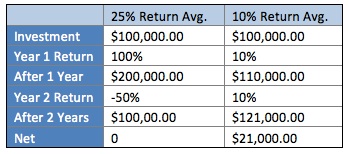Consistency Is the Key to Investing When You're Retired
Once your account is dormant, you can no longer use the volatility of the markets to your advantage.

Most investors, and even some advisers, do not understand the difference between active and dormant accounts. But knowing how to invest in each is paramount to having a successful retirement.
In an active account, such as a 401(k), 403(b) or individual retirement account, you're still buying assets and contributing regularly. When the market goes down in value, you probably don't like it, but you don't worry excessively because you're still buying shares, and you can get them at a lower price. That helps you recover more quickly when the market goes up. Buying mutual fund shares regularly in an active account can be appropriate for some investors because you can take advantage of the volatility.
You generally want to avoid mutual funds in a dormant account, however. A dormant account is any account that you are not putting money into on a monthly basis; or even less ideal, an account from which you are withdrawing money. Both stock and bond markets are volatile, and the fee structure of a mutual fund acts like an anchor over time on dormant account. When the market goes down in value, you are going to lose money, and you will not be using the volatility to your advantage. Instead you have to wait and hope that the market recovers.
From just $107.88 $24.99 for Kiplinger Personal Finance
Become a smarter, better informed investor. Subscribe from just $107.88 $24.99, plus get up to 4 Special Issues

Sign up for Kiplinger’s Free Newsletters
Profit and prosper with the best of expert advice on investing, taxes, retirement, personal finance and more - straight to your e-mail.
Profit and prosper with the best of expert advice - straight to your e-mail.
For example, let's say your lifestyle needs require you to take out 5% annually from the $1,000,000 in your account, or $50,000. If you continue to do so when your account total has dropped, the amount you withdraw can never go back up in value. It's gone. You don't recover from that type of scenario. That's why it is typically inadvisable to depend solely on an account that fluctuates with the markets to provide you with retirement income.
Still, I meet with people every day who have dormant accounts that are 80% or 100% invested in mutual funds. In most cases, it's a scenario that isn't working well for them. Over the last 10 years, it hasn't been a good approach, in my opinion, nor do I see it as an appropriate strategy for the next decade.
Put another way: If you have one dollar invested in a stock market index, and the market crashes, losing 50% of its value, your dollar will be worth 50 cents. If you sit tight and the next year the market rallies, gaining 50%, do you have your dollar back? No, you have 75 cents. You'd have to have a return of 100% to offset the 50% loss.
Once your account goes dormant, you're better off investing in assets that will not lose value due to market volatility. Examples include certain annuities (fixed and indexed), certificates of deposit or exchange-traded funds with a stop-loss attached to it. Whatever type of investment you prefer, the most important thing is that you avoid volatility.
Consistency is what counts when you're retired and relying on a dormant account for income. If you get a 10% average return on your money, that can actually outperform a 25% average return.
Let me go over an example of how it works: Say that you put $100,000 in a potentially volatile investment—perhaps someone convinced you that in the long run you would be fine. The first year it works well for you: You chose the right initial public offering or technology stock and got a 100% return. You now have $200,000. You're happy, so you do it again, and in the second year, because of a market correction, you lose half the account value. You're back to $100,000. It went up 100%, but then it went down 50%. On average, your return over the two-year period is 25%—but in reality, you know you haven't gained a cent. And when you enter fees into the equation, it makes the situation even worse.

Now let's say that you don't want to take a whole lot of risk, and you look for more consistency. So you put your $100,000 into an account, and the first year you get a 10% return. Your $100,000 is now $110,000. The second year you invest the same way and get another 10% return. You now have $121,000. The average advertised rate of return on that investment is 10%. The other accounts advertised average rate of return is 25%, but the account that averaged 10% is worth more money.
It's the volatility, therefore, that can destroy a retirement. You need consistent, predictable, and all-but-guaranteed results when the account must support your lifestyle for the next 10, 20 or 30 years. It's all really very simple math. It's the way that the numbers shape up through consistent returns year after year after year. It's a wise strategy that can allow you to live more boldly in retirement.
Matt Dicken is the founder and CEO of Strategic Wealth Designers, a financial services firm working to help both retirees and pre-retirees on the path toward a more confident financial future. He is an Investment Adviser Representative and insurance professional.
Steve Post contributed to this article.
Profit and prosper with the best of Kiplinger's advice on investing, taxes, retirement, personal finance and much more. Delivered daily. Enter your email in the box and click Sign Me Up.

Matt Dicken is the founder and CEO of Strategic Wealth Designers, a financial services firm working to help both retirees and pre-retirees on the path toward a more confident financial future. He is an Investment Adviser Representative and insurance professional. Dicken is the author of two books and host of the TV show "Strategic Wealth with Matt Dicken," which airs on ABC and CBS affiliates.
-
 AI Stocks Lead Nasdaq's 398-Point Nosedive: Stock Market Today
AI Stocks Lead Nasdaq's 398-Point Nosedive: Stock Market TodayThe major stock market indexes do not yet reflect the bullish tendencies of sector rotation and broadening participation.
-
 Top Tech Gifts to Grab at Walmart Before Christmas
Top Tech Gifts to Grab at Walmart Before ChristmasBig savings on Apple, Bose, HP, Vizio and more while there's still time to shop.
-
 AI Appliances Aren’t Exciting Buyers…Yet
AI Appliances Aren’t Exciting Buyers…YetThe Kiplinger Letter Artificial intelligence is being embedded into all sorts of appliances. Now sellers need to get customers to care about AI-powered laundry.
-
 Quick Question: Are You Planning for a 20-Year Retirement or a 30-Year Retirement?
Quick Question: Are You Planning for a 20-Year Retirement or a 30-Year Retirement?You probably should be planning for a much longer retirement than you are. To avoid running out of retirement savings, you really need to make a plan.
-
 Don't Get Caught by the Medicare Tax Torpedo: A Retirement Expert's Tips to Steer Clear
Don't Get Caught by the Medicare Tax Torpedo: A Retirement Expert's Tips to Steer ClearBetter beware, because if you go even $1 over an important income threshold, your Medicare premiums could rise exponentially due to IRMAA surcharges.
-
 I'm an Insurance Pro: Going Without Life Insurance Is Like Driving Without a Seat Belt Because You Don't Plan to Crash
I'm an Insurance Pro: Going Without Life Insurance Is Like Driving Without a Seat Belt Because You Don't Plan to CrashLife insurance is that boring-but-crucial thing you really need to get now so that your family doesn't have to launch a GoFundMe when you're gone.
-
 I'm a Tax Attorney: These Are the Year-End Tax Moves You Can't Afford to Miss
I'm a Tax Attorney: These Are the Year-End Tax Moves You Can't Afford to MissDon't miss out on this prime time to maximize contributions to your retirement accounts, do Roth conversions and capture investment gains.
-
 I'm an Investment Adviser: This Is the Tax Diversification Strategy You Need for Your Retirement Income
I'm an Investment Adviser: This Is the Tax Diversification Strategy You Need for Your Retirement IncomeSpreading savings across three "tax buckets" — pretax, Roth and taxable — can help give retirees the flexibility to control when and how much taxes they pay.
-
 Could an Annuity Be Your Retirement Safety Net? 4 Key Considerations
Could an Annuity Be Your Retirement Safety Net? 4 Key ConsiderationsMore people are considering annuities to achieve tax-deferred growth and guaranteed income, but deciding if they are right for you depends on these key factors.
-
 I'm a Financial Pro: Older Taxpayers Really Won't Want to Miss Out on This Hefty (Temporary) Tax Break
I'm a Financial Pro: Older Taxpayers Really Won't Want to Miss Out on This Hefty (Temporary) Tax BreakIf you're age 65 or older, you can claim a "bonus" tax deduction of up to $6,000 through 2028 that can be stacked on top of other deductions.
-
 Meet the World's Unluckiest — Not to Mention Entitled — Porch Pirate
Meet the World's Unluckiest — Not to Mention Entitled — Porch PirateThis teen swiped a booby-trapped package that showered him with glitter, and then he hurt his wrist while fleeing. This is why no lawyer will represent him.